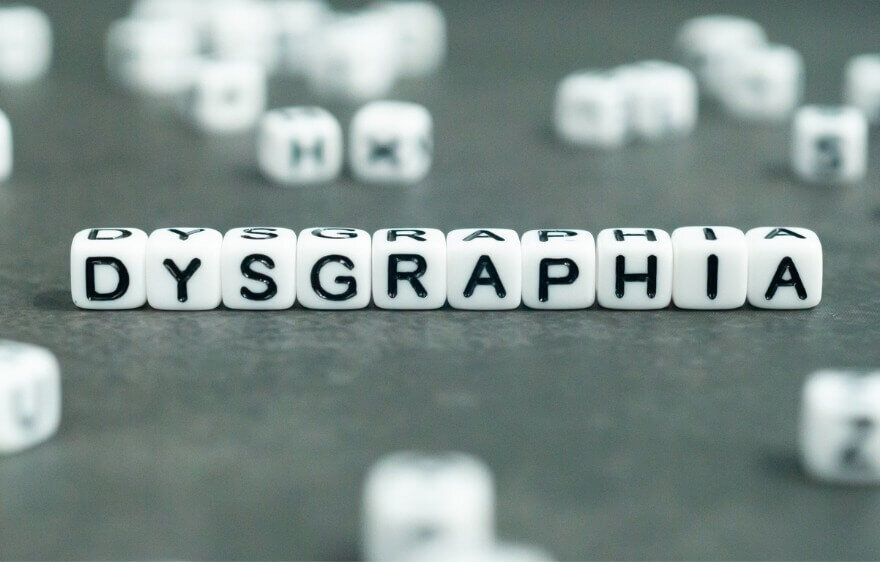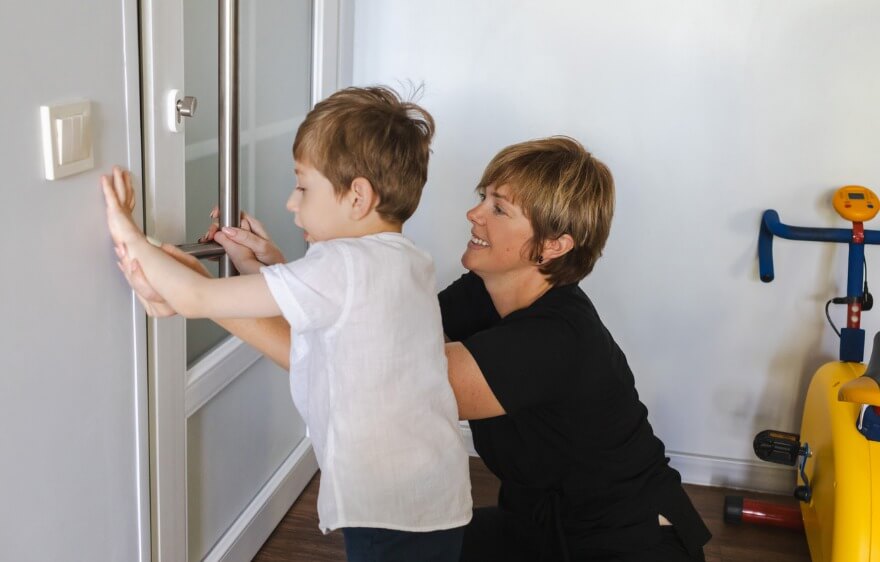From difficulties forming letters to organizing thoughts on paper, writing challenges are a common source of frustration for children and parents alike. If you’ve noticed your child struggling with writing and have questions about causes and potential therapies, you’re not alone. One possible cause for many writing-related challenges is dysgraphia, a learning disability that affects handwriting, fine motor skills, and written expression.
The good news? There are effective options for managing this condition. Occupational therapy for dysgraphia can play a significant role in helping your child develop the necessary skills to overcome these obstaclesando thrive academically and personally.
In this easy-to-understand guide, we’ll dive into how dysgraphia can impact your child’s day-to-day life and how occupational therapy can be a game-changer for improving writing and communication skills. You’ll also learn how occupational therapists can tailor interventions to your child’s unique needs with specific approaches, including developing fine motor skills, sensory play, and fostering self-expression.
What Is Dysgraphia?
Dysgraphia is a neurological condition that impairs a person’s ability to write. It isn’t just about messy handwriting or difficulty spelling — dysgraphia affects both the physical act of writing and the cognitive processes behind it. Children with dysgraphia often experience challenges with forming letters, spacing words, organizing thoughts on paper, and maintaining consistent handwriting speed. In some cases, dysgraphia can also make it difficult for children to express their ideas clearly and coherently in writing, despite having a strong understanding of the material.
Dysgraphia often manifests in different ways. Some children may struggle with motor coordination, leading to poor fine motor control and slow, uneven handwriting. Others may experience issues with spatial organization, such as improper spacing between words or lines. Additionally, dysgraphia can impact cognitive functions, including the ability to plan and organize written work, making it difficult for children to convey their thoughts in an organized and logical manner.
While dysgraphia is a lifelong condition, children can learn to manage the challenges that come with it. Occupational therapy for dysgraphia offers tailored, evidence-based strategies to help children build essential skills that will make a significant difference in their ability to write and function in everyday life.
How Occupational Therapy Can Help Children With Dysgraphia
Occupational therapy for dysgraphia focuses on helping children develop the necessary skills to improve their handwriting, fine motor abilities, and overall written expression. An occupational therapist (OT) will work closely with your child to assess their specific challenges and create an individualized treatment plan. The goal of occupational therapy for dysgraphia is not only to improve handwriting but also to help children feel more confident in their academic work and daily tasks.
OTs are skilled at addressing the root causes of dysgraphia and can provide both short-term and long-term support. By understanding every child’s unique needs and strengths, occupational therapy for dysgraphia can be customized to suit individual abilities, learning styles, and goals. Here are some key ways an OT can assist in managing and overcoming the challenges of dysgraphia:
1. Developing Fine Motor Skills
Fine motor skills are essential for writing. Children with dysgraphia often have underdeveloped fine motor abilities, making it difficult for them to hold a pencil correctly or form letters and shapes accurately. Occupational therapy for dysgraphia focuses on strengthening these skills through various exercises and activities.
To help improve hand strength, dexterity, and control, an OT might incorporate activities like:
- Building with blocks or LEGO sets: Working with toys and games can help strengthen hand muscles and improve hand-eye coordination.
- Cutting with scissors: This task enhances control over hand movements and can improve the ability to manipulate a writing utensil.
- Beading or stringing: These fine motor tasks help children develop finger strength and coordination.
- Playdough or clay activities: Kneading, rolling, and shaping playdough can be a fun way to enhance hand strength.
By engaging in these hands-on activities, children gradually improve their motor skills, making it easier for them to hold a pencil and form legible letters.
2. Improving Pencil Grip and Posture
Many children with dysgraphia struggle with the proper pencil grip or experience discomfort while writing. Occupational therapy for dysgraphia can help by teaching children the correct grip and posture that can make writing easier and more comfortable.
An OT may use various techniques, such as:
- Hand Strengthening Exercises: To develop a proper grip and improve hand endurance during writing tasks.
- Using Adaptive Tools: Specially designed grips or pencil aids may help children maintain a proper and relaxed grip, reducing hand fatigue.
- Posture Adjustments: Ensuring that your child is sitting with the correct posture at a desk or table can greatly improve their ability to write comfortably.
By focusing on these foundational skills, children with dysgraphia can become more comfortable with writing tasks and reduce the physical strain that often accompanies this challenge.
3. Sensory Play and Integration
Sensory processing difficulties are common among children with dysgraphia. These children may struggle with processing touch, sight, and awareness of where their body is in space, which can make tasks like writing feel overwhelming or uncomfortable.
Sensory play is an essential part of occupational therapy for dysgraphia. OTs use sensory activities to help children better understand and regulate their sensory responses, which in turn makes writing and other tasks less stressful. Some common sensory activities that may be used include:
- Sensory Bins: Filling a bin with materials like rice, sand, or water beads provides tactile input that helps children with sensory sensitivities.
- Weighted Blankets or Vests: These tools can help children self-regulate and calm their bodies, making it easier for them to focus on writing tasks.
- Swinging or Rocking: Activities that incorporate movement can help children develop body awareness and improve their ability to sit still and concentrate while writing.
- Tactile Writing Surfaces: Tracing letters in sand or on textured paper can provide a multisensory approach to letter formation and writing practice.
Sensory play encourages children to engage with their environment in a way that promotes relaxation and focus, which is essential for writing tasks.
4. Developing Handwriting and Written Expression Skills
One of the core focuses of occupational therapy for dysgraphia is improving handwriting and written expression. Through a combination of fine motor exercises and cognitive strategies, children can learn to write more efficiently and clearly.
OTs may introduce techniques such as:
- Multi-Sensory Writing: Teaching children to form letters using tactile (touch), auditory (sound), and visual (sight) input can reinforce the connection between motor movement and letter formation.
- Letter Formation Practice: An OT may work with your child on forming letters and numbers using large, easy-to-handle writing tools before transitioning to smaller pencils.
- Writing Drills and Repetition: Regular practice helps children build muscle memory, making handwriting less effortful and more automatic.
- Organizational Strategies: For children who struggle with organizing their thoughts on paper, OTs can use graphic organizers or mind maps to help them structure their ideas before writing.
This combination of motor and cognitive support ensures that children are equipped with the tools they need to improve both the physical act of writing and the content of their written work.
Tailoring Occupational Therapy for Dysgraphia to Your Child’s Needs
Because dysgraphia affects each child differently, occupational therapy for dysgraphia is highly individualized. If you believe your child may benefit from occupational therapy, an OT can assess your child’s specific strengths and challenges and tailor interventions to suit their unique needs. Some children require extra support in fine motor coordination, while others may need more help with sensory integration or writing strategies.
It’s important to remember that progress may take time, but with patience and consistent therapy, many children with dysgraphia show significant improvement. An OT can provide regular feedback to parents and caregivers, helping you stay informed and involved in your child’s progress.
Empowering Families With Occupational Therapy for Dysgraphia
Dysgraphia can be a frustrating and isolating challenge for children and their families. However, with the right support, children can overcome many of their writing and communication-related obstacles. Occupational therapy for dysgraphia offers a compassionate, individualized approach to help children develop the skills they need to succeed in school and beyond.
By focusing on improving fine motor skills, pencil grip, sensory regulation, and written expression, OTs can empower children to feel more confident in their abilities. Whether it’s through engaging sensory play, fine motor exercises, or organizational strategies, occupational therapy for dysgraphia provides the tools for your child to reach their full potential.
If you believe your child may benefit from occupational therapy for dysgraphia, don’t hesitate to reach out to an occupational therapist who specializes in this area. The earlier your child receives support, the sooner they can start building the skills they need to succeed. With the right guidance, your child can thrive despite the challenges of dysgraphia, turning writing from a daunting task into a skill they can master.
Schedule Your Child’s Care Assessment Today
At Care Options for Kids, we understand the unique challenges of caring for a child with health conditions. Our dedicated team of pediatric therapists is here to support your family with compassionate, expert care tailored to your child’s needs. Contact us today to schedule an assessment and learn how we can help you navigate this journey with confidence and care.
Click here to start your journey to better care.
This post is for educational and informational purposes only. You should always speak with your own therapist before implementing this information on your own.






